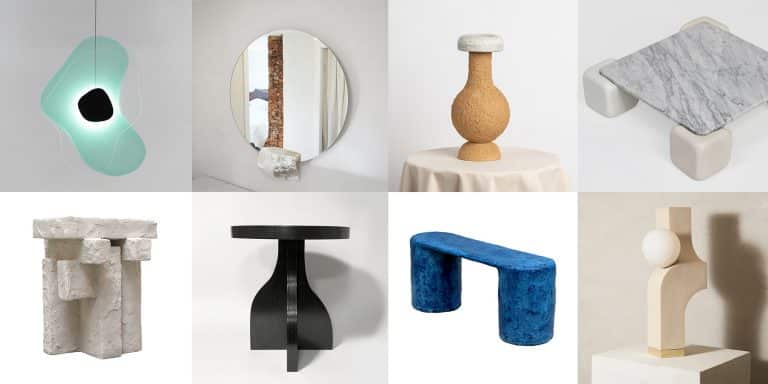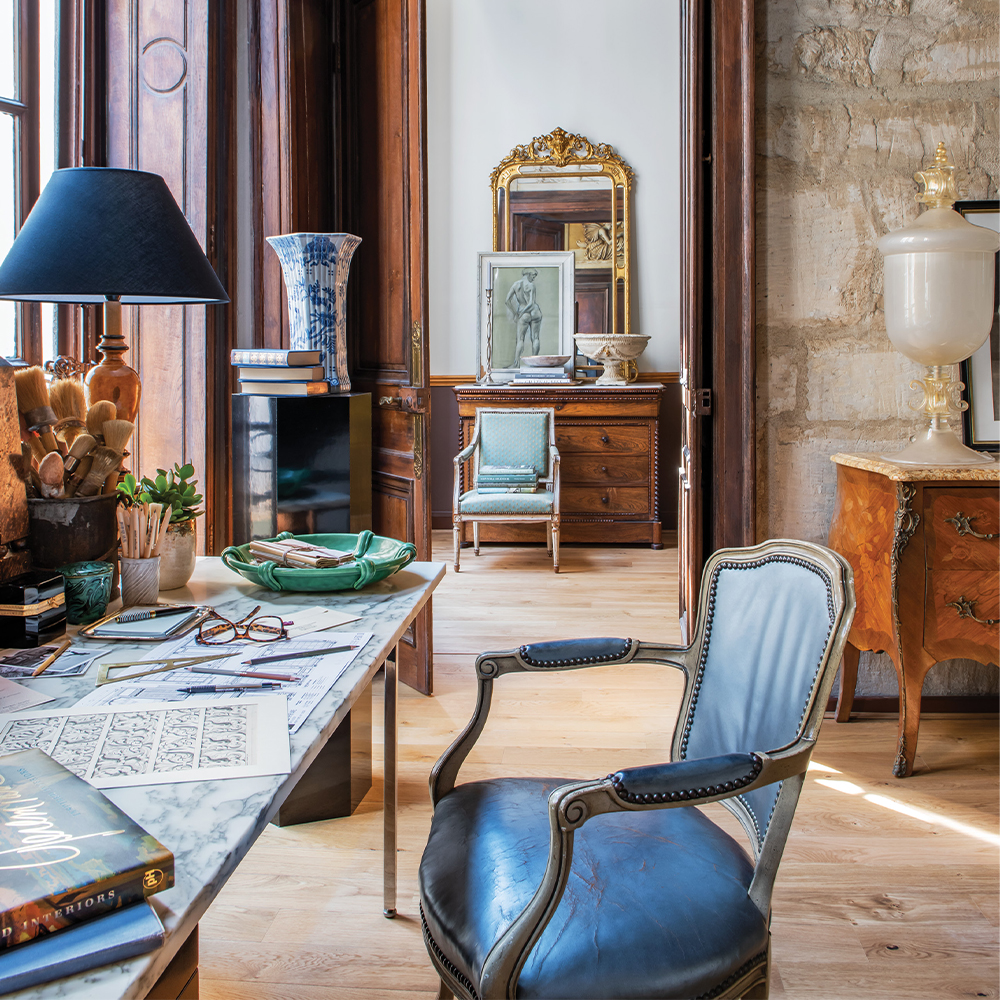
June 2013Photos courtesy of Lázaro Rosa-Violán Studio
Arriving late for our recent lunch date at La Société, the sleek and stylish Paris eatery, Barcelona-based interior designer Lázaro Rosa-Violán apologizes as he enters, attributing his delay to the bad weather that has stymied flights all over Europe. Trimly handsome, with a small beard and mustache, he wears an understated tweed jacket and smiles warmly, explaining that his English is poor but that Devin Winter, his American director of marketing and global business development, will help out with our conversation.
Our meeting had already migrated from Barcelona to Paris because of a too-tight schedule that saw Rosa-Violán visiting his projects in Madrid, Stockholm, Paris and Barbados — all in less than a week’s time. These days, an itinerary like this is more typical than not for Rosa-Violán, who, since establishing his studio 10 years ago, has become one of Europe’s most in-demand interior designers, with prestigious commissions for hotels, restaurants, shops and private residences around the world. “My projects always have two things in common,” Rosa-Violán says, explaining his aesthetic, “a sense of history and the ambiance of a comfortable home.”

The Barcelona-based Lázaro Rosa-Violán Studio has applied its worldly and timeless aesthetic to some of Europe’s most striking new hotels and restaurants, including Cheri, a French-American bistro in Barcelona with a Catalonian twist.
Rosa-Violán is fresh from visiting a new project called Nosh and Chow, in Stockholm, which occupies a 150-year-old townhouse and features hotel suites as well as two restaurants and a speakeasy-style bar, images of which he shows me on a laptop. Gold-trimmed cabinets frame its stately entrance while a red-and-gold patterned rug provides further opulence. Old-fashioned globe lights shine on the gleaming wooden bar, with copper pipes on the ceiling matching the warmth of the golden-brown parquet floor. A fireplace and wooden cabinets filled with glittering bottles enhance the warm atmosphere.
What one won’t see in these marvelous interiors, however, is anything remotely Swedish or a theme of any kind running through the rooms. “I want to surprise,” he says. “I want every place I design to look like it could be anywhere in the world.”
The designer fills all of his projects with one-of-a-kind elements: a 200-year-old map and a series of vintage photographs here, some Japanese pottery there, plus a floor salvaged from a 19th-century building and an ancient Chinese screen. Elsewhere, you might find leaded-glass panels or vintage retro chairs from an out-of-the-way shop.

The main dining room at Nosh and Chow — a recently opened Stockholm boutique hotel with a bar and two restaurants — prominently displays a chandelier and chairs designed by Rosa-Violán’s studio.

At Barcelona’s Cotton House Hotel, the designer brought an opulent, modern perspective to the Art Nouveau style that once dominated the city.
Wherever Rosa-Violán travels, he finds new things that fascinate him, most of which eventually make their way into his projects. (Only a small percentage of the furnishings that he uses are not found objects.) In a sense, he uses these pieces to create an original history for each place. “I call myself an urban archaeologist,” he says. “I have collected so much that I keep two warehouses in Barcelona, with hundreds of my discoveries, looked after by a team of connoisseurs. I call them my Ali Baba caves.”
On a trip to Barcelona a few days after our Paris lunch, I find that these discoveries also spill over into Rosa-Violán’s studio in Eixample, a fashionable neighborhood best known for the fanciful architecture of Antoni Gaudí and his acolytes. Located in a former textile factory, the office houses a 31-member staff of industrial designers, draftsmen, graphic designers and production coordinators. (His sister Mar is his business partner and financial manager.)
The bike riders among the staff store their helmets under a handsome wooden entrance table on which sits an immense vase filled with palm fronds. Every room in his studio and the adjacent apartment shows the designer’s fascination with history: He’s decorated the kitchen with a 19th-century hand-painted French screen, and glass doors from Barcelona’s original Ritz Hotel comprise the entry to the dining room. A Picasso gouache hangs over the mantel above wedding tea pots from China. Mirror-paneled doors from a Catalan palace open to the bedroom, which is decorated with a framed 17th-century Turkish caftan and German botanical posters from the ’40s mounted in black boxes. Books fill the shelves in every room.

At Madrid’s Suarez, a family-owned jewelry store, Rosa-Violán gave the wares plenty of room to breath
Rosa-Violán’s background is as distinctive as his designs. He was born in Tangier, Morocco, and spent his early years in the Basque city of Bilbao, living with his Catalonian parents, two brothers and four sisters. “I had good luck when we moved to Bilbao,” he says. “We moved into the house of a shipping heir who had a beautiful home during the golden age of industrial design. It was very elegant, sophisticated and artistic. I felt the ambiance even as a child.”
By age eight, he was studying with the esteemed Basque artist Marina Sainz de Rozas, then head of the painting department at the University of Bilbao. He proved so talented that when his parents took him to an art fair in Brussels a year after he began working with de Rozas, the paintings he’d brought sold out. Encouraged by members of the university’s art department, he left grade school at the age of 10 and began studying painting there full time, continuing with architecture and design at university in Madrid when he turned 18. After graduating, he moved to Paris to paint, spending a few summers in a cottage in northern England.

For Barcelona’s Beppe Restaurant, the designer looked to some of Federico Fellini’s favorite spots in Rome, saying he wanted to “recreate the brasseries of via Veneto Roman splendor.”
He was having success as a painter when, in 1998, one of his brothers recommended that he design a restaurant on the Balearic island of Formentera. He took a three-month break to create the space, designing it around the natural landscape — something no other designer had previously done on the island (though others soon followed his lead). Called Can Vent, it became an overnight success and still thrives today. Shortly thereafter the Andilana Group asked him to create its chain of restaurants in Barcelona, Madrid and, eventually, the Philippines. Design-magazine editors soon began chasing him down, quickly followed by the biggest players in the hospitality industry.

Nosh and Chow’s UN Bar provides long views across the hotel’s foyer and into its main dining room.
Rosa-Violán’s painter’s eye and sense of structure, design and shape never left him, however, as becomes immediately apparent on a tour of his Barcelona projects. Even just walking into the reception area of his sleek Hotel Pulitzer gives a sense of how he combines the contemporary with the traditional to create spaces in which an individual can feel at home while surrounded by historic objects.
He trimmed the front desk with a gold floral design rescued from an ancient church in Palermo, Sicily, and placed a sumptuous, gold velvet couch across from it. Across the mahogany floor, light streams in from tall wood-framed windows. Down a hallway, one comes to the spacious bar and lounge, where bright red Chinese cabinets with brass fixtures hold rows of liquor bottles; tall wooden stools, topped by white cushions, fit comfortably under the white marble bar. Further on, two handsome white leather couches frame a streamlined fireplace, on which stands an angular fossil from Madagascar. The mirror above the fireplace catches light from the enclosed garden beyond.
After completing the Barcelona tour — including the lively restaurant Toto, with its fabric ceiling and ceramic walls; the chic Oysho boutique, owned by the worldwide Zara chain, and the glittering and comfy Boca Grande restaurant — it’s hard to imagine what else Rosa-Violán could want to design. But he dreams big.
“I’d like to design a museum and a big library,” he says. “I like to challenge myself, to create, to make people feel good and to feel important.”
He also has a more mundane dream. “I’d love to spend more time with my dog, Bosco. He’s a Weimaraner. When I’m home, he’s my shadow. My favorite moments are when we escape to the Costa Brava on weekends and he gets a chance to swim.”


